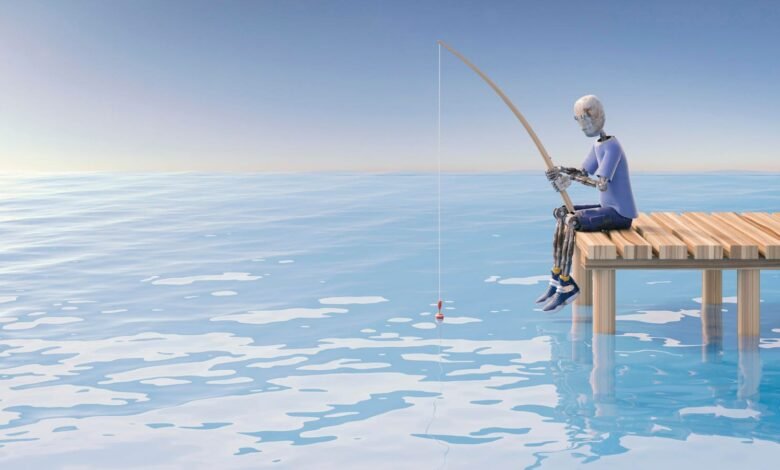How AI Anchors The Future Of Fishing & Charts The Course To Sustainability

The future of fishing is more than robot fisher-people and smart refineries.
In the vast, blue expanse of our planet’s oceans, a revolution is quietly unfolding, poised to redefine the ancient practice of fishing for the modern era. This revolution, powered by artificial intelligence (AI), is not just transforming how we harvest the seas; it’s ensuring we do so sustainably, preserving our marine ecosystems for generations to come. As we delve into this fascinating journey, we uncover the innovative ways in which AI is becoming the cornerstone of sustainable fishing, offering a beacon of hope for the future of our oceans.
AI: The Vanguard of Ocean Conservation
At the heart of sustainable fishing lies the critical challenge of balancing human needs with the health of marine ecosystems. AI emerges as a powerful ally in this endeavor, providing unprecedented tools that enable fishermen, conservationists, and policymakers to make informed decisions that protect our oceanic resources.
One inspiring example of AI in action is the development of smart, AI powered fishing nets equipped with cameras and sensors. These nets distinguish between species, sizes, and even the age of marine life, allowing non-target species to escape unharmed. This technology significantly reduces bycatch, a major issue in commercial fishing, where unintended species are caught and often perish, disrupting marine biodiversity.
Robot fish can help monitor fish populations and illegal fishing practices.
Precision Fishing with AI
In a huge advancement, AI introduces better precision to the fishing industry through predictive analytics. By analyzing data from satellite imagery, oceanographic sensors, and historical catch records, AI models can predict fish populations’ locations and movements with remarkable accuracy. This capability enables fishermen to target specific areas, reducing the time and resources spent on unproductive fishing while minimizing environmental impact.
For example, a project by the Nature Conservancy uses machine learning algorithms to analyze vast datasets, identifying patterns that predict fish behaviors and habitats. This project not only aids in directing fishermen to abundant fishing grounds but also helps in setting up marine protected areas where fishing is restricted, thereby supporting fish population recovery.
Monitoring and Enforcement through AI
AI’s role extends beyond the act of fishing itself, contributing to monitoring and enforcement efforts against illegal, unreported, and unregulated (IUU) fishing. Illegal fishing practices are a significant threat to sustainable fisheries, often involving overfishing and the destruction of habitats. AI surveillance systems can monitor vast oceanic regions, analyzing ship movements to detect suspicious activities indicative of IUU fishing.
Global Fishing Watch, an initiative that leverages AI and satellite technology, offers a powerful example. It provides a near real-time view of global fishing activities, making it easier for authorities to track and combat illegal fishing operations. This transparency not only deters illicit activities but also encourages accountability and compliance with sustainable fishing regulations.
AI is becoming a powerful tool in rehabilitating marine ecosystems.
AI for Ecosystem Health Analysis
Understanding and maintaining the health of marine ecosystems is crucial for sustainable fishing. AI algorithms can process and analyze data from underwater drones, satellites, and sensor networks, assessing the health of marine environments. This analysis can detect early signs of stress, such as coral bleaching, pollution, or de-oxygenation, prompting timely interventions to mitigate damage and support ecosystem resilience.
One innovative application of this technology is AI coral reef monitoring. These projects utilize AI to analyze images of coral reefs, identifying changes over time that may indicate ecological shifts. By providing early warnings of reef degradation, conservation efforts can be more effectively targeted to preserve these vital ecosystems, which are crucial for marine biodiversity and the livelihoods of millions of people.
Empowering Communities with AI
The benefits of AI in sustainable fishing are not confined to industrial operations; they also empower local and indigenous communities. By providing access to AI tools and insights, these communities can better manage their traditional fishing grounds, ensuring they remain productive and healthy for future generations. A heartening example comes from small island nations in the Pacific, where AI is used to combine traditional knowledge with modern science in managing fish stocks. Local fishers use apps powered by AI to log catch data, contributing to community-led conservation efforts and sustainable fisheries management.
AI powered smart fisheries is just one of the first steps people are taking.
Challenges and the Path Forward
While AI presents a promising avenue for sustainable fishing, challenges remain. Data privacy, equitable access to technology, and the need for global cooperation are pressing issues that need to be addressed. Moreover, the success of AI in sustainable fishing depends on continuous innovation, investment, and collaboration among tech companies, governments, NGOs, and fishing communities.
As we navigate the complex waters of sustainability, AI stands as a lighthouse, guiding the fishing industry towards a future where the bounty of the sea is harvested responsibly and conscientiously. Through the smart application of AI, we are not just enhancing the efficiency and profitability of fishing; we are embracing our collective responsibility to preserve our marine heritage. The journey towards sustainable fishing, powered by AI, is a testament to human ingenuity and our enduring commitment to protecting our planet. It is a journey of hope, innovation, and respect for the natural world that sustains us, promising a healthier, more abundant ocean for all.
Source link




